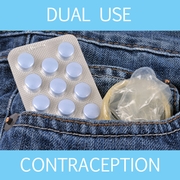Spreading the Message: Dual Contraceptive Method Use Among Teens
By ETR | November 4, 2016
Two heads are better than one! It’s an old but familiar adage. We have an updated version we’d like to suggest: two contraceptives are better than one.
ETR researchers have just published an article in The Journal of Primary Prevention that examines the frequency of dual contraceptive use among youth in alternative schools. Information about this population is particularly important because they are more likely than other youth to engage in risky sexual behaviors. To date, there has been no research examining dual use contraception in this group.
Coyle, K.C., Peterson, A.J., Franks, H.M., Anderson, P.M., Glassman, J.R. (2016). Dual contraceptive method use among youth in alternative schools. The Journal of Primary Prevention 37(5). Published online October 31, 2016.
Dual Contraceptive Methods
Dual use contraceptive methods involve the use of both a hormonal method (oral contraceptives, long-acting reversible contraceptives, etc.) and a barrier method (condoms). This approach provides strong protection against both pregnancy and STDs.
Context Matters
Overall, rates of dual contraceptive use were low (about 20% in females, 17% in males). However, these figures are comparable to rates among other populations of youth.
Our researchers explored the association between dual contraceptives and relationship style—that is, having one steady partner, having a mix of steady and non-steady, or having only non-steady partners. Youth reporting only non-steady partners were more likely to use dual methods.
This is not surprising. Other studies have suggested that condom use tends to decrease as youth move from a non-steady to a steady relationship. Sex without a condom is seen by some youth as a sign of deeper intimacy and greater trust.
ETR researchers have done previous work exploring the importance of context in romantic relationships, particularly as it relates to sexual risks. Youth risk-taking is influenced by a partners’ view of the relationship, their friends’ perspectives and their own attitudes.
This current article is an exciting step in building our knowledge-base about ways to promote dual contraceptive methods among youth. We congratulate our team on the publication and look forward to seeing more of their work.





